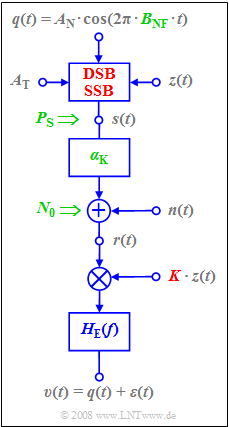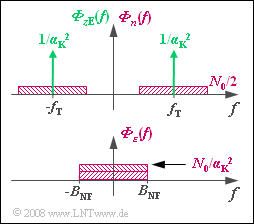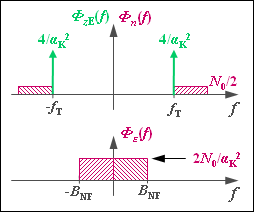Exercise 2.10Z: Noise with DSB-AM and SSB-AM
Now the influence of noise on the sink-to-noise power ratio 10·lgρv for both DSB–AM and SSB–AM transmission will be compared. The illustration shows the underlying block diagram.
The differences between the two system variants are highlighted in red on the image, namely the modulator (DSB or SSB) as well as the dimensionless constant
- K={2/αK4/αKforforDSB,SSB
of the receiver-side carrier signal zE(t)=K·cos(ωT·t), which is assumed to be frequency and phase synchronous with the carrier signal z(t) at the transmitter.
The system characteristics
- frequency-independent channel transmission factor αK,
- transmission power PS,
- one–sided noise power density N0,
- bandwidth BNF of the source signal,
captured by the shared performance parameter are labelled in green:
- ξ=α2K⋅PSN0⋅BNF
Further note:
- The cosine signal q(t) with frequency BNF stands for a source signal with bandwidth BNF composed of multiple frequencies.
- The relationship between the transmission power PS and the power Pq of the source signal depends, among other things, on the modulation method.
- "DSB–AM with carrier" is parameterized by the modulation depth m=AN/AT,
while "SSB-AM" is determined by the sideband-to-carrier ratio μ=AN/(2·AT). - The frequency-independent channel transmission factor αK is balanced by the constant K, so that in the noise-free case (N0=0),
the sink signal v(t) matches the source signal q(t). - The sink SNR can thus be given as follows (T0 indicates the period of the source signal):
- ρv=PqPεwithPq=1T0⋅∫T00q2(t)dt,Pε=∫+BNF−BNFΦε(f)df.
Hints:
- This exercise belongs to the chapter "Single-Sideband Modulation".
- Particular reference is made to the section "Sideband-to-carrier ratio".
- The results for DSB–AM can be found in the section "Sink SNR and the performance parameter".
Questions
Solution
(2) Answer 2 is correct:
- For DSB–AM without a carrier, PS=Pq/2. This is simultaneously the power of the useful component of the sink signal v(t).
- The power-spectral density Φε(f) of the v(t) noise component results from the convolution:
- Φε(f)=ΦzE(f)⋆Φn(f)=1α2K⋅[δ(f−fT)+δ(f+fT)]⋆Φn(f).
- The expression [ ... ] describes the power-spectral density of a cosine signal with the signal amplitude K=2.
- The correction of channel attenuation is considered with 1/α2K .
- Thus, taking Φn(f)=N0/2 into account, we get:
- Φε(f)=N0α2K⇒Pε=∫+BNF−BNFΦε(f)df=2⋅N0⋅BNFα2K.
- From this, it follows for the the signal-to-noise power ratio (SNR):
- ρv=PqPε=2⋅PS2⋅N0⋅BNF/α2K=α2K⋅PSN0⋅BNF=ξ_.
(3) Answer 2 is correct:
- In contrast to DSB, PS=Pq/4 holds for SSB, as well as
- Φε(f)=ΦzE(f)⋆Φn(f)=4α2K⋅[δ(f−fT)+δ(f+fT)]⋆Φn(f).
- Taking BHF=BNF into account (see adjacent diagram for USB modulation), we now get:
- Φε(f)=2⋅N0α2K⇒Pε=4⋅N0⋅BNFα2K.
- This means: When without carrier, single-sideband modulation demonstrates the same noise behaviour as DSB-AM.
(4) Assuming a cosine carrier with amplitude AT and a similarly cosine source signal q(t), we get for DSB with carrier:
- s(t)=(q(t)+AT)⋅cos(ωT⋅t)=AT⋅cos(ωT⋅t)+AN2⋅cos((ωT+ωN)⋅t)+AN2⋅cos((ωT−ωN)⋅t).
- The transmission power is thus given by
- PS=A2T2+2⋅(AN/2)22=A2T2+A2N4.
- Taking Pq=A2N/2 and m=AN/AT into account, this can also be written as:
- PS=A2N4⋅[1+2⋅A2TA2N]=Pq2⋅[1+2/m2].
- With the noise power Pε according to subtask (2) we thus obtain:
- ρv=PqPε=2⋅PS⋅(1+2/m2)2⋅N0⋅BNF/α2K=α2K⋅PSN0⋅BNF⋅11+2/m2.
- And in logarithmic representation:
- 10⋅lgρv=10⋅lgξ−10⋅lg[1+2/m2].
- ⇒10⋅lgρv (m=0.5)=40dB−10⋅lg(9)=30.46dB_
- ⇒10⋅lgρv (m=1.0)=40dB−10⋅lg(3)=35.23dB_.
(5) In "SSB–AM" there is only one sideband.
- Therefore, considering the sideband-to-carrier ratio μ=AN/(2AT) gives:
- PS=A2T2+(AN/2)22=A2N/8⋅[1+4⋅A2T/A2N]=Pq/4⋅[1+1/μ2].
- Thus, with the noise power from subtask (3) we obtain:
- ρv=PqPε=4⋅PS⋅(1+1/μ2)4⋅N0⋅BNF/α2K=α2K⋅PSN0⋅BNF⋅11+1/μ2⇒10⋅lgρv=10⋅lgξ−10⋅lg[1+1/μ2].
- So we get the same result with SSB-AM as in DSB-AM with a modulation depth of m=√2·μ. From this, it further follows:
- 10⋅lgρv(SSB,μ=0.5/√2)=10⋅lgρv(DSB,m=0.5)=30.46dB_,
- 10⋅lgρv(SSB,μ=1.0/√2)=10⋅lgρv(DSB,m=1.0)=35.23dB_.


